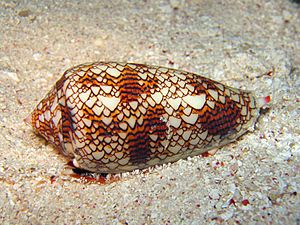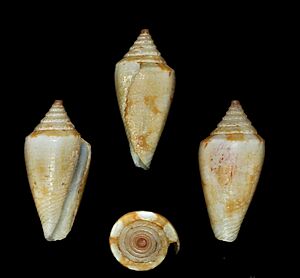Textile cone facts for kids
Quick facts for kids Textile cone |
|
|---|---|
 |
|
| A live individual of Conus textile, head end towards the right | |
| Conservation status | |
| Scientific classification | |
| Synonyms | |
|
See "List of synonyms" |
The Conus textile, also known as the textile cone or cloth of gold cone, is a type of sea snail. It is a venomous ocean gastropod mollusk belonging to the family Conidae, which includes all cone snails. These snails are found mostly in the Indian Ocean, along the eastern coast of Africa, and around Australia.
Like all cone snails, the textile cone is a predatory animal that uses venom to catch its food. They can "sting" humans, so it's very important to be careful and avoid touching them if you see one alive. Their sting can be dangerous. In 2021, a teenager had a very serious experience after picking up a live textile cone.
Contents
About the Textile Cone Snail
The textile cone snail is a fascinating creature. It gets its name from the beautiful patterns on its shell, which look a bit like woven fabric. These snails are an important part of the ocean's ecosystem.
What Does it Look Like?
Adult textile cone snails usually grow to be about 9 to 10 centimeters (3.5 to 3.9 inches) long. Some can even reach up to 15 centimeters (5.9 inches)! The patterns on their shells are quite unique. They look a bit like a special kind of computer pattern called "Rule 30."
The shell is usually yellowish-brown. It has wavy brown lines that run up and down. These lines are broken up by white triangle shapes. These white triangles are scattered all over, but they are closer together near the top, middle, and bottom of the shell, forming bands. The top part of the shell, called the spire, has similar markings. The opening of the shell, called the aperture, is white.
Where Does it Live?
The Conus textile snail lives in warm ocean waters. You can find them in the Red Sea and the tropical Indo-Pacific region. This includes areas off Australia (like New South Wales, Northern Territory, Queensland, and Western Australia). They also live near New Zealand, in the Indian Ocean from eastern Africa all the way to Hawaii, and around French Polynesia.
How Does it Live?
The textile cone snail has an interesting way of life. It reproduces and hunts for food in the ocean.
Life Cycle
Female textile cone snails lay hundreds of eggs at one time. These eggs usually hatch after about 16 or 17 days. Once the tiny larvae hatch, they float in the ocean currents for about 16 days. After this time, they settle down onto the ocean floor. At this point, they are very small, only about 1.5 millimeters (0.06 inches) long.
What Does it Eat?
The Conus textile is a carnivorous (meat-eating) snail. It uses a special tool called a radula, which is like a tiny, harpoon-shaped tooth. This radula injects a powerful venom called conotoxin into its prey. The textile cone snail mainly eats other snails.
The snail has a long, flexible tube called a proboscis. The harpoon-like tooth is at the end of this tube. The snail can extend its proboscis to reach any part of its own shell. Because of its venom, a live textile cone snail can be dangerous to anyone who handles it without being very careful.




